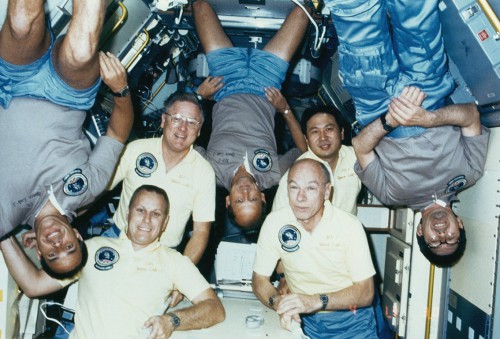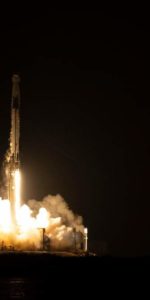
By default, at 7:13 p.m. EST today, Victor Glover—currently serving aboard the International Space Station (ISS) as a member of the Expedition 64 crew—becomes the most flight-experienced African-American astronaut. He will pass fellow astronaut Stephanie Wilson, whose current record of just less than 43 days was accrued on three Space Shuttle missions between July 2006 and April 2010. Glover is six weeks into a planned multi-month increment aboard the ISS, having been launched aboard Dragon Resilience on 15 November. Both Glover and Wilson were also recently named as members of NASA’s “Artemis Team” to support humanity’s return to the Moon.
Fifteen African-American citizens have traveled to space between August 1983 and now. Of their number, we are particularly reminded of those who strived for space, but never made it home: Challenger’s Ron McNair, Columbia’s Mike Anderson and the Air Force’s Manned Orbiting Laboratory (MOL) astronaut selectee Robert H. Lawrence, in whose honor last spring’s NG-13 Cygnus cargo ship was named. Indeed, had the hands of fate turned more kindly for Lawrence, there is every likelihood that he might have become the first African-American astronaut and perhaps the first black shuttle commander.

Lawrence died, aged only 32, whilst flying backseat as an instructor pilot on an F-104 Starfighter in December 1967. Had he lived, he would surely have joined fellow MOL research pilots Gordon Fullerton, Karol “Bo” Bobko, Bob Crippen, future shuttle spacewalker Don Peterson, Bob Overmyer, Dick Truly and Hank Hartsfield in being picked by NASA as its seventh class of astronauts in September 1969. And since all but Peterson went on to fly as shuttle pilots and commanders, it is highly probable that Lawrence might have flown in the front-right seat of one of the orbiters in the early 1980s.

As circumstances transpired, the first spacefarer of African ancestral heritage who made it to space was Cuba’s Arnaldo Tamayo Méndez, who flew an eight-day voyage with Soviet cosmonaut Yuri Romanenko—father of future ISS cosmonaut Roman Romanenko—in September 1980. Aboard Soyuz 38, they docked to the Salyut 6 space station and worked for several days alongside the resident crew of cosmonauts Leonid Popov and Valeri Ryumin.

By the time of Tamayo Méndez’s flight, however, NASA had already selected four African-American men for astronaut training. In January 1978, Air Force officers Guy Bluford and Fred Gregory and civilian physicist Ron McNair had been picked to join the first class of shuttle astronauts, with Marine Corps aviator and future NASA Administrator Charlie Bolden chosen in May 1980.

With such emphasis upon diversity within an astronaut corps which had previously been an all-white affair, it was perhaps unsurprising that one of these new selectees should draw an early shuttle crew assignment. In April 1982, NASA named Bluford to STS-8, then planned for mid-1983 to deploy a large Tracking and Data Relay Satellite (TDRS). However, problems with the satellite’s booster caused it to be scrubbed from the mission and replaced with an Indian communications satellite and a large Payload Flight Test Article (PFTA). Not dissimilar to a gigantic dumb-bell, the PFTA was part of an ongoing campaign to test the capabilities of the shuttle’s 50-foot-long (15-meter) Remote Manipulator System (RMS) mechanical arm.
STS-8 began on 30 August 1983, marking the first shuttle mission to launch and land at night. And for Bluford, located in the center flight engineer’s seat, behind Challenger’s commander and pilot, remembered that the excitement overwhelmed him and he laughed and chuckled almost the whole way into orbit. It was the dawn of a stellar career for Bluford. Later assignments saw him lead the payload crew for the first German-sponsored Spacelab mission in late 1985—a flight which also marked Challenger’s last fully successful voyage—before receiving two complex flights for the Department of Defense in 1991 and 1992.

Six months after Bluford’s first flight, Ron McNair launched on STS-41B, assisting with the deployment of two communications satellites and supporting the first untethered spacewalks, courtesy of Martin Marietta’s Manned Maneuvering Unit (MMU). The mission ended with the shuttle’s first successful touchdown at the Kennedy Space Center (KSC). Two years later, in January 1986, McNair was tragically killed when Challenger broke apart in the cold Cape Canaveral sky, just 73 seconds after launch.

In April 1985, Fred Gregory—who went on to become NASA Deputy Administrator, later in his career—became the first African-American to pilot a space mission, when he rode the front-right seat aboard Challenger on STS-51B, a weeklong Spacelab flight. He subsequently commanded two Department of Defense missions in 1989 and 1991, becoming the first black astronaut to lead a spaceflight. In his NASA oral history, Gregory recalled being unconcerned about any “historic” element of the assignment; he was simply doing his job.

And in January 1986, just days before the loss of Challenger, Charlie Bolden piloted Columbia and might have flown again later that same year to deploy Hubble. As circumstances transpired, Bolden remained attached to the Hubble mission which finally flew in April 1990 and later commanded two missions of his own: an Earth sciences research mission in March 1992 and the joint flight with the Russians in February 1994. Like Gregory, he rose to the higher echelons of the space agency, becoming the first African-American NASA Administrator during the incumbency of President Barack Obama.

With the resumption of shuttle operations in the wake of the Challenger tragedy, black astronauts increasingly played their part. In September 1992, the first African-American woman—medical doctor Mae Jemison—flew aboard Spacelab-J, a co-operative mission between the United States and Japan, and in February 1995 another physician, Bernard Harris, became the first black person to perform a spacewalk. He spent four hours and 39 minutes working outside shuttle Discovery on STS-63, a mission which also earned its place in the history books by completing a rendezvous with Russia’s Mir space station.

Spacewalking would also be conducted by African-American astronauts Winston Scott, Bob Curbeam, Bobby Satcher and Al Drew, most recently during the final voyage of shuttle Discovery in March 2011. Between them, these four men logged 14 sessions of Extravehicular Activity (EVA), totaling over 90 hours spent working outside their respective spacecraft in orbit. Curbeam, with seven EVAs under his belt, remains the most experienced African-American spacewalker, having logged 45 hours and 33 minutes across a career which has included the delivery of the U.S. Destiny lab in early 2001 and the end-to-end rewiring of the ISS electrical grid in December 2006.

Other seasoned spacefarers include Stephanie Wilson—until 7:13 p.m. EST tonight the world’s most flight-experienced African-American astronaut, with 42 days and 23 hours across three shuttle missions—and Joan Higginbotham, both of whom participated in several high-profile construction flights to the space station, together with Mike Anderson, the only African-American astronaut to board Mir, who later lost his life in the Columbia disaster in February 2003. Leland Melvin, who took primary responsibility for the delivery of Europe’s Columbus lab to the ISS in February 2008, went on to serve as NASA’s Associate Administrator for Education.
We should also not forget those African-American candidates who were considered for spaceflights, but who never actually flew. In the early 1960s, as a direct consequence of the equal-rights rhetoric espoused by the Kennedy Administration, Air Force bomber pilot Ed Dwight was briefly considered for astronaut training. But the political push to get Dwight into NASA’s astronaut corps went nowhere.

“The trouble was, his multi-engine background, lack of an engineering degree and lack of the normal test pilot school caused him to be ranked pretty far down the list of applicants,” wrote Deke Slayton in his memoir, Deke, co-authored with Michael Cassutt. Slayton, one of the Original Seven Mercury astronauts, headed the Flight Crew Operations Directorate during the 1960s. “It wasn’t racism, it was just that according to the rankings, Dwight had finished in the middle of the pack.”

And in the 1980s, Air Force officer Livingston Holder trained for a spot on a classified shuttle mission as a Manned Spaceflight Engineer (MSE), whilst Michael Belt served as backup payload specialist for STS-44 in late 1991.

More recently, assigned crew member Jeanette Epps was controversially pulled from an ISS expedition in early 2018, in what would have made her the first black person to fly a long-duration mission to the space station. That accolade went instead, just last month, to Victor Glover, who launched aboard Crew-1 and became the first African-American astronaut to board the ISS since the departure of Al Drew almost a decade ago. For her part, Epps was named last summer to the first operational Boeing CST-100 Starliner mission, now expected to launch in early 2022.

And as Glover tonight eclipses Stephanie Wilson’s record, these two titans of African-American accomplishment in space now find themselves assigned to the “Artemis Team”, with the very realistic possibility—alongside 2017 selectee Jessica Watkins—that they could visit the Moon and perhaps leave their bootprints in lunar soil a few short years from now.
FOLLOW AmericaSpace on Facebook and Twitter!
Missions » SLS » Artemis »





I’m neither black or white but am glad to finally see the first long duration mission by a black astronaut.
It would also be great to see a black man or woman on the Moon. In fact it would be great to see ANY human being walk on the Moon.
But at 50 years of age it’s doubtful I shall live to see it happen, as Artemis 3 (NASA’s intended crew Moon landing mission) seems certain to be pushed back to the late 2020s if at all.
“We should also not forget those African-American candidates who were considered for spaceflights, but who never actually flew. In the early 1960s, as a direct consequence of the equal-rights rhetoric espoused by the Kennedy Administration, Air Force bomber pilot Ed Dwight was briefly considered for astronaut training. But the political push to get Dwight into NASA’s astronaut corps went nowhere.”
. In my analysis as a space program veteran and spaceflight historian, Dwight had too many too heavy loads to struggle with that had nothing to do with bigotry, since the White House required him to take three day weekends DURING the ‘aerospace research pilot’ training in 1963 for national speaking engagements promoting JFK policies, while the other pilots spent full time on classes, books, and flying [his final class standing was 8th out of 16]. Dwight’s expected White House backing failed to persuade NASA to pick him on public relations grounds [he admits he did not rate high enough on technical merit but blames this on the impact of his White-House-demanded publicity campaigns — a plausible explanation]. The AF put him on their list of nominees for the 1963 selection but after consideration NASA did not even invite him to Houston for final interviews [only the top 2 of his ARPS class were finally selected]. Kennedy’s death the following month obviously had nothing to do with the already-made NASA decision. In addition to his class standing and massive White-House-imposed public relations duties, NASA’s decision may also have been based on physical stature: at 5’03” he was three inches shorter than the minimum design spec for pilot height for the Apollo Lunar Module, requiring he carry a footstool onto any moon-landing mission he might have been assigned to.